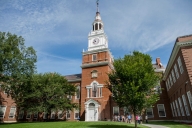You have /5 articles left.
Sign up for a free account or log in.
Considered an underrated powerhouse by some, Indiana University grabbed the attention of other research universities last month when it announced a $300 million initiative aimed at asking -- and answering -- some of the world’s biggest questions. In so doing, it joined a growing number of research institutions to launch similar programs centered on big ideas.
Beside boosting a university’s public profile, advocates of such “grand challenge” research programs say they help cut down silos across campus and reorient the university mission back toward the public good. But such research has its critics, too, who say that these initiatives are often ill defined and tend to favor the life and physical sciences over other fields. So Indiana’s bold move also opened it up to possible criticism, should its initiative fail to meet expectations.
Fred Cate, Indiana’s vice president for research, is undaunted by the project’s inherent risk.
“What are the real needs facing society, and let’s figure out how the university can organize itself to address those needs,” Cate said, explaining the university’s rationale for its new Grand Challenges program. “It’s a really important and long overdue characterization of the university. We’re not here to gratify the interests of the faculty -- in the long run, we’re here to serve the public interest.”
Over the next five years, Indiana will invest $300 million in the Grand Challenges program to develop transformative solutions for some of the planet’s most pressing problems. Up to five large-scale research projects will be selected through a competitive review process that will consider proposals’ impact on quality of life in Indiana. But the project also has a global focus, in that proposals are supposed to be address those challenges that are “too big to ignore,” such as global water supply, energy availability, infectious diseases, harnessing the power of big data, and climate change.
Ideally, projects will involve collaborative, interdisciplinary research and partnerships with community organizations, industry and government.
The university is now accepting preliminary proposals from faculty teams for the first two Grand Challenge grants, to be funded starting next fall. Three more projects will be funded between now and 2020.
Cate said the program is part of the university’s strategic plan, and that there’s a good amount of faculty buy-in, even though -- or perhaps because -- the program asks faculty members to work in new ways. Administrators also have more of a role in setting research priorities than is frequently the case. The university actually sees the program as a faculty recruitment tool; although only current faculty members may submit proposals, a good amount of funds will be devoted to recruiting top faculty members to campus to join selected projects.
“University faculty typically operate with a fair amount of autonomy, and that’s a good thing,” Cate said. “But most of these issues require a team approach, and this is a way to create incentives to get people to come together in teams and open doors.”
Cate said the university is totally open to faculty members’ proposals, and said that he suggested such possible topics as global water supply, energy availability and infectious diseases only to help spark faculty members’ imaginations. Asked if the program might have a bias toward the life and physical sciences -- as critics of other past initiatives have pointed out -- Cate said it would be hard to imagine a topic that didn’t relate to science, technology, math and engineering. But it would also be hard to imagine one that only related to those fields, he added.
“These challenges may be in many cases defined in ways that include the sciences, but I don’t think we’re going to solve any of them without thinking more broadly,” he said, noting that nearly all possible proposals have implications for education and public policy, for example.
Addressing additional criticisms that such big ideas-oriented projects are hard to assess or otherwise measure progress, Cate said the university is looking for how they impact life beyond campus. Grand Challenges isn’t just about getting “the science right, but also can you get people to use the science, and can you educate people about the science and is the science deployed in the right way?”
Numerous institutions have devoted significant resources to large-scale projects seeking to address major challenges or big ideas in recent years. Some 93 faculty members from 29 academic units at Princeton University have participated in its Grand Challenges program since it was launched in 2007, for example, working on environmental issues in climate and energy, sustainable development in Africa, and global health and infectious diseases.
Some universities also have launched big ideas-related research initiatives in one area. Stanford University, for example, last year announced its neurosciences institute was taking on seven new priorities, to be tackled by interdisciplinary teams spanning schools and disciplines. And the University of Michigan recently said it will spend $100 million over the next five years on research and teaching related to data science -- mostly on new faculty members, as well as expanding support for interdisciplinary research in data science and research computing capacity.
A number of universities have been inspired by the White House Office of Science and Technology Policy’s 21st Century Grand Challenges program. Launched in 2013, the program promotes goals that harness science, technology and innovation to solve key national or global problems, and that “have the potential to capture the public’s imagination.”
“That’s why we’re pursuing other grand challenges, like making solar energy as cheap as coal or making electric vehicles as affordable as the ones that run on gas,” President Obama said during a news briefing announcing the program, which is part of his Strategy for American Innovation. “They’re ambitious goals but they’re achievable. We’re encouraging companies, research universities and other research organizations to get involved and help us make progress.”
The University of California at Los Angeles's Grand Challenges program, which Indiana looked to as it was drafting its own initiative, was inspired in part by Obama’s call to action. UCLA’s process was much different in that its big ideas -- cutting the burden of depression in half by 2050 and eliminating it by the end of the century, and making the Los Angeles region 100 percent sustainable in water and energy without harming biodiversity by the year 2050 -- were developed by volunteer faculty members through consensus over several months. The university also didn’t tack a price tag onto the program outright.
“If you’re using this as a means to bring the campus together, it’s better not to use prizes for identifying the grand challenge,” said Michelle Popowitz, assistant vice chancellor for research and executive director of UCLA Grand Challenges. “It’s better to use a prize for the breakthroughs you need.”
But the goals of the programs are similar nevertheless, she said. “Our view is that you need multiple perspectives on how to solve these big issues.”
Nelson Freimer, director of the Center for Neurobehavioral Genetics and a professor of psychiatry at UCLA, is helping lead the depression challenge. He said that from a faculty perspective, he’d “never been involved in anything that has involved such sustained and interactive involvement from so many faculty members form across so many disciplines where there’s a common purpose but not an immediate payoff.”
Despite having gone out on such a limb without assurances that it won’t be “lopped off or land safely, so to speak,” the process has been worth it, he said.
“The scale of this project is part of the reason it’s gotten the [faculty] response it has,” Freimer said. “We were sort of given the mandate of proposing something great and ambitious and impactful not just scientifically but on society, and that has been in itself incredibly exciting.”
Too Big to Succeed?
But not everyone is as enthusiastic about big team or big idea science. A recent study in Science Advances, for example, argues that large-team research might not produce the expected return on investment. The authors suggest that’s because ineffective communication, redundant efforts, inefficient organization and increased costly bureaucracy can hobble creativity and create opportunity costs where faculty members could be working on their more independent research.
David Leebron, president of Rice University, said he’s not necessarily opposed to big ideas-type research science. In fact, the university is partnering with several other institutions in a multimillion-dollar water treatment project. But Rice in general is more focused on providing faculty with the resources they need to answer ask and answer questions than defining them, Leebron said.
“We’re a little more methodological in that sense,” he said. “We’re building scientific capacity, not putting a straitjacket on it.”
Rice just announced, for example, a $150 million strategic initiative aimed at increasing its research competitiveness, establishing a world-class data sciences program and increasing its standing among molecular nanotechnology research hubs. The research money will fund new faculty positions and technology, but the university hasn’t said how it must otherwise be used.
“It’s not like we’re blind -- if we invest in this molecular nanotechnology we know that two of the primary things [that will be studied] are energy and health care,” Leebron said. “That makes sense for us in Houston. A very big factor for us, which we decided on in the beginning, was that we need to invest in things that could be leveraged locally and internationally.”
But the lack of further directives “reflects a little more a belief that faculty are in the best position to think about and answer questions that haven’t been so well defined by the central administration, and in giving them tools to that end. … These problems aren’t going to be solved at any one university.”
Harvey J. Graff, Ohio Eminent Scholar in Literacy Studies and a professor of English and history at Ohio State University, has written about the positive and negative aspects of interdisciplinarity, including in his recent book, Undisciplining Knowledge: Interdisciplinarity in the Twentieth Century. He’s been particularly critical of federal “wars” on social and biosciences problems, such as poverty and cancer, that in his view have failed to yield results.
Such efforts demand “serious review with a firm eye to learning lessons on how to organize our efforts and use our resources better," he said via email. “There is far too much overselling and faddishness. … There are better, broader, sounder and more inclusive paths toward knowledge and problem solving.”
At the institutional level, Graff said he is firmly committed to knowledgeable, grounded interdisciplinary research and scholars and institutions keeping “big picture” challenges in their sights. But he’s also “skeptical of single-institutional initiatives that claim to solve more problems than they can list.”
That’s because such initiatives seldom if ever specify their actual questions, processes, resources or decision making, he said. Instead, they’re too often “self-serving public relations efforts dictated by external boards and lacking in faculty participation in their creation and shaping. As a result, they promise far too much.”
For starters, they exclude faculty members who could contribute, stimulating ill will and counterproductivity, Graff said. Efforts are ill defined, he added, and they tend to “detract attention and resources away from the liberal arts (including the sciences as well as the arts, humanities and social sciences) toward a somewhat limited version” of STEM. His own university’s Discovery Themes data analytics initiative fell into such traps, he added.
Leebron called research initiatives of various kinds -- whether they seek to build up an existing capacity or to answer those big questions -- a response to the current state of research funding and the related challenges all universities face. With less federal funding to go around, he said, initiatives have to be strategic and, in many cases, bold.
“Universities are going to be called upon to make bets and take risks, so they can’t just let every faculty member go out on their own,” as they may have once been able to, he said.









